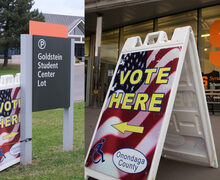New Yorkers on parole vote for president for 1st time after 2018 order
Nabeeha Anwar | Presentation Director
Gov. Andrew Cuomo restored voting rights to tens of thousands of New Yorkers on parole through a partial pardon in May 2018.
The Daily Orange is a nonprofit newsroom that receives no funding from Syracuse University. Consider donating today to support our mission.
Darryle Jones sat in his Brooklyn apartment on Friday, staring at the television as results trickled in from the first presidential election he had voted in.
Jones had followed the election closely ever since he was released from Fishkill Correctional Facility, a medium-security prison 85 miles north of New York City. A year-and-a-half earlier, an executive order by Gov. Andrew Cuomo had restored voting rights to tens of thousands of New Yorkers on parole through a partial pardon.
The 2020 election marked the first time New Yorkers on parole, like Jones, could vote for president.
“You feel a part of the community, a part of the society that your vote counts,” Jones said. “Your say-so counts.”
Since May 2018, 62,070 New Yorkers on parole with felony convictions have received the partial pardon, the New York State Department of Corrections and Community Supervision said in an email to The Daily Orange. Just under 10,600 had their voting rights revoked again, according to the corrections department.
Efforts to restore voting rights to parolees have gained steam in recent years, said Nicole Porter, director of advocacy for The Sentencing Project. Delaware repealed a five-year waiting period for most offenses. Virginia restored voting rights post-sentence. Florida voters also passed a voting rights amendment that allowed people with felony records to vote, but Republican legislators passed legislation that essentially reversed voters’ decisions.
“There was a long period that people were focused on voting. People were focused on different communities voting,” said Porter. “And then the attention devoted to voters with felonies benefitted from that level of attention and that level of awareness.”
As the 2020 election approached and the coronavirus pandemic hit New York state prisons, advocates pressured the corrections department to shrink the prison population. More inmates were released on parole as a result. Since March, 9,034 parolees have received the partial pardon, the department said in the email.
Cuomo cites the 15th Amendment in the order, which prohibits governments from denying voting rights based on race. About 80% of disenfranchised voters due to criminal convictions identified as African American or Hispanic in the census as of 2009, according to a report from The Brennan Center for Justice.
After Cuomo signed the order, then-Chairman of New York’s Republican Party, Ed Cox, described it an “outrage power grab” that is “purely political, designed to appeal to radical primary voters and satisfy his presidential ambitions.”
When Jones stepped out of Fishkill Correctional Facility, the corrections department placed his name on a list of parolees. The list went to the Governor’s Office, which went through the list, person-by-person, considering factors for each parolee that include maintaining regular contact with their parole officer and “remaining at liberty at the time of review.”

Darryle Jones was enrolled in Syracuse University’s now-defunct prison education program while in Auburn Correctional Facility. Courtesy of Darryle Jones
There are currently bills in the New York state’s Assembly and Senate that would restore voting rights to people on parole automatically. New Yorkers who have completed parole or are on probation are allowed to vote.
“It’s been in the conversation,” said Onondaga County Board of Elections Commissioner Dustin Czarny. “I don’t know (that) it’s been the foremost part of voting rights for New York, mainly because we already had felon reinfranchisement unlike Florida and other states.”
Aside from receiving a list of pardons each month, Czarny said there “has not been a lot of communication” with Cuomo’s office.

On Election Day, Jones woke up, made his morning coffee and made a plan to vote at the library a few blocks down from his apartment that served as his polling place. He found out he could vote last November, from a flyer that hung from the wall of the parole office he visits.
He thought about what time he would vote. It had to be soon, before he left for his maintenance job in Manhattan.
Jones said efforts to suppress voters, including threats by President Donald Trump to downscale the United States Postal Service ahead of an expected surge in mail-in ballots, had increased turnout in his community. When he arrived at his polling place, he saw lines stretching around the corner.
“That’s why people are turning out so much in droves,” he said.
Published on November 9, 2020 at 11:45 pm
Contact Gabe: gkstern@syr.edu | @gabestern326






